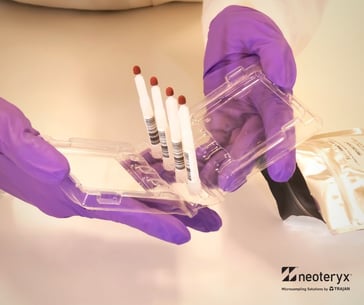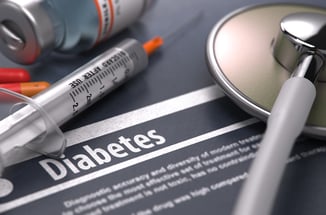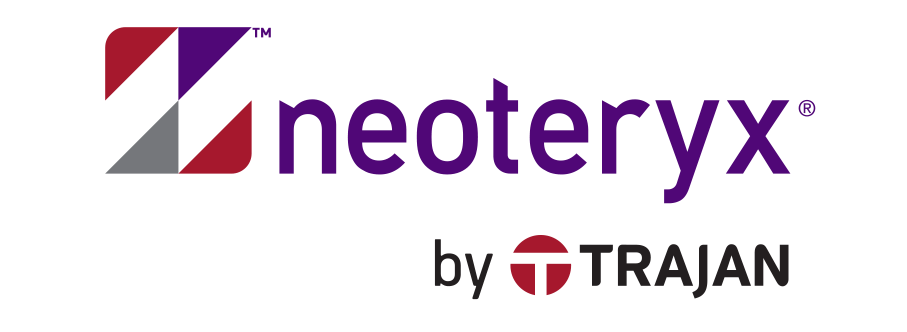Share this
microsampling to differentiate type 1 vs type 2 diabetes
by James Rudge, PhD, Technical Director, Trajan on Nov 22, 2021 9:00:00 AM
An article published in the March 2018 issue of the Journal of Diabetes Science and Technology, reported on the use of blood microsamples to measure C-peptide as a biomarker for the differentiation of type 1 versus type 2 diabetes. The paper, entitled “Microsampling Collection Methods for Measurement of C-peptide in Whole Blood,” describes a pilot study that involved collecting blood using three different methods: capillary tubes, dried blood spot (DBS) and volumetric absorptive microsampling.
 The blood collected with capillary tubes was centrifuged for plasma samples. Simultaneously, samples were collected using DBS cards and Mitra® devices with VAMS® technology.
The blood collected with capillary tubes was centrifuged for plasma samples. Simultaneously, samples were collected using DBS cards and Mitra® devices with VAMS® technology.
Blood from both types of microsamplers was extracted prior to assaying for C-peptide alongside the corresponding plasma samples.
The researchers analyzed plasma levels from harvested plasma to plasma equivalent levels of the peptide from VAMS and DBS on two immunoassay platforms. The research team, members of the Diabetes Research Unit at Swansea University in the United Kingdom, demonstrated that reliable values could be obtained from both microsampling methods, though they found that VAMS provided more reliable results compared to DBS.
Background on C-peptide and Its Role in Diabetes Diagnosis and Monitoring
 As recently reported by the BBC Scotland is rolling out a C-peptide blood test to monitor insulin production in newly diagnosed type 1 diabetics for the first three years. The purpose of this is to determine if the pancreas of diabetic patients is still secreting insulin (the hormone responsible for reducing blood glucose levels).
As recently reported by the BBC Scotland is rolling out a C-peptide blood test to monitor insulin production in newly diagnosed type 1 diabetics for the first three years. The purpose of this is to determine if the pancreas of diabetic patients is still secreting insulin (the hormone responsible for reducing blood glucose levels).
A Primer on the Two Types of Diabetes
There are a primarily two of types of diabetes. The first is type 1, where the insulin secreting beta-cells of the islets of Langerhans, found in the pancreas, are attacked through an autoimmune process. The reason for this is not fully understood but may involve microbiome dysbiosis or persistent enteroviral infections. Subsequent loss of insulin production leads to raised blood glucose levels, which can lead to weight loss and death from malnutrition (as well as other reported complications).
The second is type 2 diabetes, which is linked to an unhealthy lifestyle where a lack of exercise, obesity and a diet rich in refined carbohydrates causes insulin resistance that leads to raised blood glucose levels. Type 2 diabetes can often be controlled by diet, exercise and medication such as metformin, which acts to stimulate insulin production and efficacy.
Diabetes Treatments
The most popular treatment for type 1 diabetes are insulin injections, but these can be difficult to manage. If proper insulin dosing isn’t carefully monitored and controlled, there is a risk that too much insulin can trigger hypoglycemic episodes, which can be life-threatening. Furthermore, too little insulin can lead to hyperglycemia which can lead to complications, such as diabetic kidney disease and increased morbidity.
Diabetes Diagnosis
Diagnosis of diabetes involves measurement of glucose resistance and elevation of the long-term diabetic marker glycosylated hemoglobin (HbA1c), which we have previously reported on. Neither approach to a diabetic diagnosis clearly discerns the classification of the disease. However, measurement of C-peptide can help with monitoring insulin production.
Understanding Insulin Production and the Role of C-peptide
When the pancreas is stimulated to secrete insulin due to an increase in serum glucose -- often as a result of a meal -- the pancreas first synthesizes a peptide called proinsulin, which is made up of insulin and C-peptide. The final stage of insulin production and release is enzymatic cleavage of proinsulin into the two subunits. Insulin is a transient hormone. Its ½ life is approximately 2-3 minutes. In part, it is metabolized by fast pass metabolism in the liver. However, the physiologically inactive C-peptide fragment has a ½ life of 20-30 minutes (excreted by the kidney), making it a more stable predicate biomarker for insulin production.
As a result, C-peptide is an ideal biomarker for monitoring pancreatic activity. It can help to discern the difference between type 1 and 2 diabetes. Moreover, the C-peptide approach can also monitor pancreatic activity, even in the presence of administered insulin. This is because injected insulin is given as pure insulin and not as proinsulin. This makes monitoring the pancreatic activity of insulin-dependent diabetes possible. In fact, recent guidelines developed by the American Association of Clinical Endocrinologists (AACE) and the American College of Endocrinology (ACE), recommend that C-peptide levels should be documented when there is doubt over the diagnosis of T1 or T2 diabetes.
Challenges in Testing for C-peptide
Current tests for C-peptide involve 24-hour urine collection or measurement of urinary C-peptide creatine ratio. Both tests are less than ideal. Further, the choice of test is also dependent on the sex of the individual. Measurement of serum C-peptide levels is problematic due to proteolytic cleavage of the protein. However, C-peptide measured from whole EDTA blood (from harvested plasma) has been reported to be stable for 24 hours. Blood sampling may be a better option than urine sampling but collecting and transporting venous blood can also be challenging.
Given the drawbacks with collecting and transporting venous samples as well as the logistical problems with 24-hour urine collection, access to an easy blood collection alternative and a dried blood assay for diabetes research would be ideal. It has been highlighted in the paper from Swansea University that C-peptide is stable from dried blood samples collected via DBS for more than seven days at room temperature. Furthermore, a previous paper showed that the peptide remained stable for 6 months. For these reasons, the team at Swansea University compared extracts from Mitra® devices with VAMS® to extracts from conventional DBS to see if there was an added benefit to analyzing volumetrically collected samples.
C-peptide VAMS vs DBS Study: Methods & Findings
- Capillary blood microsamples were collected from staff members using VAMS and DBS and compared to plasma that was harvested and frozen.
- All three sample types were then analyzed by chemiluminescent immunoassay and/or ELISA using reagents as diluents and extractions (in the case of the dried blood microsamples).
- Blood plasma correction factors (CF) were applied to both VAMS and DBS. The reason for this is because levels of C-peptide are lower in whole blood compared to plasma.
- The CF was calculated for VAMS assuming 50% of blood volume was plasma and considering the known volume of the samplers (10 µL or 20 µL). The values were then reported as “5.6 and 2.8 for the chemiluminescence assay (10 μl and 20 μl VAMS, respectively) and 7.35 and 3.67 for the ELISA (10 μl and 20 μl VAMS, respectively)”. These were then confirmed by linear regression plots.
- For DBS, the CF could not be calculated due to the variation of blood but was obtained from regression plots. The CF was reported as 4.3.
- In terms of statistical analysis, linear regression was used to evaluate C-peptide levels of plasma and DBS / VAMS. Comparison of the different dried sample types compared to plasma reference, using CL immunoassay, was obtained using Bland-Altman plots. Finally, constant or proportional bias, was identified using Passing-Bablock analysis.
- It was noted that both dried methods were more convenient than venipuncture and would not require a phlebotomist for sample collection or dry ice for sample transport.
- Both techniques showed good agreement in measuring C-peptide, which correlated with what had been previously reported in the literature.
- Although good stability had been reported in the literature for DBS, the group in Swansea saw an 11% drop after 24 hours of storage at room temperature, followed by storage at -20° C. The equivalent results obtained from Mitra devices with VAMS was -0.1%
- The extracts from Mitra devices were shown to be much more reproducible (CV = 4.3%) compared to DBS (CV = 26.4%). The researchers commented that “The ease of use of the Mitra could also play a role in the accuracy of collection and reduce the need for repeat sampling.” The sample size for this pilot study was relatively small, so further work would be needed to confirm efficacy of Mitra devices over other sampling methods.
Study Authors' Discussion and Conclusions
- Mitra® with VAMS® showed less bias than DBS
- Both techniques showed good agreement for C-peptide measurements
- VAMS was shown to be more reproducible and stable than DBS
- Both methods produced effective results and warrant more research
Final Thoughts from Neoteryx
As we continue into the second year of the COVID-19 pandemic, even with vaccines making in impact on our battle against the SARS-CoV-2 virus, the coronavirus war has not yet been won. It is known that the most vulnerable within our populations, such as those with diabetes and other underlying health conditions, are much more likely to experience complications from viral infections. Indeed, the American Diabetes Association has acknowledged that “People with diabetes are more likely to have serious complications from COVID-19. In general, people with diabetes are more likely to have more severe symptoms and complications when infected with any virus.”
This study demonstrates the important role that microsampling can play in the remote monitoring of biomarkers such as C-peptide for research on conditions like diabetes. The more that remote microsampling can be applied to keep diabetic patients safe at home, the more we can limit unnecessary exposure to contagious viruses while also providing crucial data for study endpoints.
This study paper was summarized for our readers by James Rudge, PhD, Neoteryx Technical Director. This is curated content. To learn more about the important research outlined in this review, visit the original article published in Journal of Diabetes Science and Technology.

Share this
- Microsampling (206)
- Research, Remote Research (119)
- Venipuncture Alternative (105)
- Clinical Trials, Clinical Research (83)
- Mitra® Device (73)
- Therapeutic Drug Monitoring, TDM (51)
- Dried Blood Spot, DBS (39)
- Biomonitoring, Health, Wellness (30)
- Infectious Disease, Vaccines, COVID-19 (24)
- Blood Microsampling, Serology (23)
- Omics, Multi-Omics (21)
- Decentralized Clinical Trial (DCT) (20)
- Specimen Collection (18)
- Toxicology, Doping, Drug/Alcohol Monitoring, PEth (17)
- Skin Microsampling, Microbiopsy (14)
- hemaPEN® Device (13)
- Preclinical Research, Animal Studies (12)
- Pharmaceuticals, Drug Development (9)
- Harpera Device (7)
- Industry News, Microsampling News (5)
- Antibodies, MAbs (3)
- Company Press Release, Product Press Release (3)
- Environmental Toxins, Exposures (1)
- July 2025 (1)
- May 2025 (1)
- April 2025 (2)
- December 2024 (2)
- November 2024 (1)
- October 2024 (3)
- September 2024 (1)
- June 2024 (1)
- May 2024 (1)
- April 2024 (4)
- March 2024 (1)
- February 2024 (2)
- January 2024 (4)
- December 2023 (3)
- November 2023 (3)
- October 2023 (3)
- September 2023 (3)
- July 2023 (3)
- June 2023 (2)
- April 2023 (2)
- March 2023 (2)
- February 2023 (2)
- January 2023 (3)
- December 2022 (2)
- November 2022 (3)
- October 2022 (4)
- September 2022 (3)
- August 2022 (5)
- July 2022 (2)
- June 2022 (2)
- May 2022 (4)
- April 2022 (3)
- March 2022 (3)
- February 2022 (4)
- January 2022 (5)
- December 2021 (3)
- November 2021 (5)
- October 2021 (3)
- September 2021 (3)
- August 2021 (4)
- July 2021 (4)
- June 2021 (4)
- May 2021 (4)
- April 2021 (3)
- March 2021 (5)
- February 2021 (4)
- January 2021 (4)
- December 2020 (3)
- November 2020 (5)
- October 2020 (4)
- September 2020 (3)
- August 2020 (3)
- July 2020 (6)
- June 2020 (4)
- May 2020 (4)
- April 2020 (3)
- March 2020 (6)
- February 2020 (3)
- January 2020 (4)
- December 2019 (5)
- November 2019 (4)
- October 2019 (2)
- September 2019 (4)
- August 2019 (4)
- July 2019 (3)
- June 2019 (7)
- May 2019 (6)
- April 2019 (5)
- March 2019 (6)
- February 2019 (5)
- January 2019 (8)
- December 2018 (3)
- November 2018 (4)
- October 2018 (7)
- September 2018 (6)
- August 2018 (5)
- July 2018 (8)
- June 2018 (6)
- May 2018 (5)
- April 2018 (6)
- March 2018 (4)
- February 2018 (6)
- January 2018 (4)
- December 2017 (2)
- November 2017 (3)
- October 2017 (2)
- September 2017 (4)
- August 2017 (2)
- July 2017 (4)
- June 2017 (5)
- May 2017 (6)
- April 2017 (6)
- March 2017 (5)
- February 2017 (4)
- January 2017 (1)
- July 2016 (3)
- May 2016 (1)
- April 2016 (2)


No Comments Yet
Let us know what you think